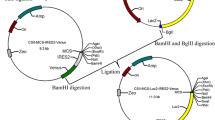Abstract
The human P2X4 purinergic receptor is an ATP gated cation-selective channel, which can be upregulated following nerve injury or stimulation by various cytokines. However, the transcriptional control of this regulation is unknown. In this study, the transcription initiation site was estimated to be 72 bp upstream of ATG start codon by using a novel sequencing based primer extension method with 5′-FAM tagged primers. To delineate the promoter region of the P2RX4 gene which encodes the P2X4 receptor, we constructed 8 fragments (size range 100–4500 bp) covering the 4.5 Kb upstream region of the P2RX4 gene. A dual-colour luciferase reporter vector system was used to measure the promoter activities in both transfected HEK-293 cells and COS-7 cells for each fragment extracted from 5 to 7 randomly picked colonies. The 62 bp sequence upstream of the initiation site showed promoter activity. A putative GATA-2 binding site (−29 to −20) within this region was required for high promoter activity and GATA-2 was found to be one of the transcriptional factors binding to P2RX4 promoter by both fluorescent super electrophoresis mobility shift assay and immunoprecipitation using streptavidin coated Dynabeads and biotin-labeled double-strand DNA probes. A single nucleotide polymorphism with minor allele frequency of 0.23 was found within the GATA-2 binding site of P2RX4 promoter region which significantly reduced gene transcription. In conclusion, our data has identified the first transcription factor involved in P2X receptor expression.




Similar content being viewed by others
Abbreviations
- EMSA:
-
Electrophoretic mobility shift assay
- PBMC:
-
Human peripheral blood mononuclear cells
- SNP:
-
Single nucleotide polymorphism
References
Soto F, Garcia-Guzman M, Gomez-Hernandez JM, Hollmann M, Karschin C, Stuhmer W (1996) P2X4: an ATP-activated ionotropic receptor cloned from rat brain. Proc Natl Acad Sci USA 93:3684–3688
Bo X, Zhang Y, Nassar M, Burnstock G, Schoepfer R (1995) A P2X purinoceptor cDNA conferring a novel pharmacological profile. FEBS Lett 375:129–133
Garcia-Guzman M, Soto F, Gomez-Hernandez JM, Lund PE, Stuhmer W (1997) Characterization of recombinant human P2X4 receptor reveals pharmacological differences to the rat homologue. Mol Pharmacol 51:109–118
Buell G, Lewis C, Collo G, North RA, Surprenant A (1996) An antagonist-insensitive P2X receptor expressed in epithelia and brain. EMBO J 15:55–62
Tsuda M, Shigemoto-Mogami Y, Koizumi S, Mizokoshi A, Kohsaka S, Salter MW, Inoue K (2003) P2X4 receptors induced in spinal microglia gate tactile allodynia after nerve injury. Nature 424:778–783
Inoue K (2006) ATP receptors of microglia involved in pain. Novartis Found Symp 276:263–272; discussion 273–281
Ulmann L, Hatcher JP, Hughes JP, Chaumont S, Green PJ, Conquet F, Buell GN, Reeve AJ, Chessell IP, Rassendren F (2008) Up-regulation of P2X4 receptors in spinal microglia after peripheral nerve injury mediates BDNF release and neuropathic pain. J Neurosci 28:11263–11268
Trang T, Beggs S, Salter MW (2006) Purinoceptors in microglia and neuropathic pain. Pflugers Arch-Eur J Physiol 452:645–652
Yamamoto K, Sokabe T, Matsumoto T, Yoshimura K, Shibata M, Ohura N, Fukuda T, Sato T, Sekine K, Kato S, Isshiki M, Fujita T, Kobayashi M, Kawamura K, Masuda H, Kamiya A, Ando J (2006) Impaired flow-dependent control of vascular tone and remodeling in P2X4-deficient mice. Nat Med 12:133–137
Wang L, Jacobsen SE, Bengtsson A, Erlinge D (2004) P2 receptor mRNA expression profiles in human lymphocytes, monocytes and CD34+ stem and progenitor cells. BMC Immunology 5:16
Qureshi OS, Paramasivam A, Yu JCH, Murrell-Lagnado RD (2007) Regulation of P2X4 receptors by lysosomal targeting, glycan protection and exocytosis. J Cell Sci 120:3838–3849
Stokes L, Surprenant A (2009) Dynamic regulation of the P2X(4) receptor in alveolar macrophages by phagocytosis and classical activation. Eur J Immunol 39:986–995
Raouf R, Chabot-Dore AJ, Ase AR, Blais D, Seguela P (2007) Differential regulation of microglial P2X4 and P2X7 ATP receptors following LPS-induced activation. Neuropharmacology 53:496–504
Tang Y, Matsuoka I, Ono T, Inoue K, Kimura J (2008) Selective up-regulation of P2X4-receptor gene expression by interferon-gamma in vascular endothelial cells. J Pharmacol Sci 107:419–427
Dignam JD, Lebovitz RM, Roeder RG (1983) Accurate transcription initiation by RNA polymerase II in a soluble extract from isolated mammalian nuclei. Nucleic Acids Res 11:1475–1489
Korenaga R, Yamamoto K, Ohura N, Sokabe T, Kamiya A, Ando J (2001) Sp1-mediated downregulation of P2X4 receptor gene transcription in endothelial cells exposed to shear stress. Am J Physiol Heart Circ Physiol 280:H2214–H2221
Harigae H (2006) GATA transcription factors and hematological diseases. Tohoku J Exp Med 210:1–9
Lurie LJ, Boyer ME, Grass JA, Bresnick EH (2007) Differential GATA factor stabilities: implications for chromatin occupancy by structurally similar transcription factors. Biochemistry 47:859
Shimizu R, Yamamoto M (2005) Gene expression regulation and domain function of hematopoietic GATA factors. Semin Cell Dev Biol 16:129–136
Tipping AJ, Pina C, Castor A, Hong D, Rodrigues NP, Lazzari L, May GE, Jacobsen SEW, Enver T (2009) High GATA-2 expression inhibits human hematopoietic stem and progenitor cell function by effects on cell cycle. Blood 113:2661–2672
LaVoie HA (2003) The role of GATA in mammalian reproduction. Exp Biol Med 228:1282–1290
Acknowledgements
We thank Dr. Leanne Stokes for helpful comments, Dr. Stephen Fuller and Ms. Leah McKinnon for organizing blood samples. This work was supported by the Cure Cancer Australia Foundation, the Leukemia Foundation of Australia and a Sesqui Fellowship from the University of Sydney (BG).
Author information
Authors and Affiliations
Corresponding author
Additional information
BG: design, most of experimental work, analysing data, writing; CS: EMSA, western blotting; VV: assistance in EMSA, mass spectrometer; KS: genotyping; JW: design, writing.
Rights and permissions
About this article
Cite this article
Gu, B.J., Sun, C., Valova, V.A. et al. Identification of the promoter region of the P2RX4 gene. Mol Biol Rep 37, 3369–3376 (2010). https://doi.org/10.1007/s11033-009-9924-5
Received:
Accepted:
Published:
Issue Date:
DOI: https://doi.org/10.1007/s11033-009-9924-5




